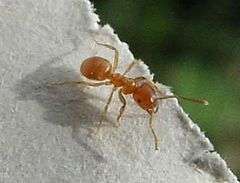Yellow meadow ant
| Yellow meadow ant | |
|---|---|
 | |
| Scientific classification | |
| Kingdom: | Animalia |
| Phylum: | Arthropoda |
| Class: | Insecta |
| Order: | Hymenoptera |
| Family: | Formicidae |
| Subfamily: | Formicinae |
| Genus: | Lasius |
| Species: | L. flavus |
| Binomial name | |
| Lasius flavus (Fabricius, 1782) | |
The Yellow meadow ant, (also yellow hill ant, formal name Lasius flavus), is one of the most common ants in Central Europe, and it also occurs in Asia, North Africa and eastern North America.
The queen is 7–9 mm long, males 3–4 mm and workers 2–4 mm. Their colour varies from yellow to brown, with queen and males being slightly more darkly colored.
The species lives primarily underground in meadows and very commonly, lawns. The nests are often completely overgrown by grass, however, often their presence is betrayed by small mounds of loose soil material between the grass stalks. They will also nest under large rocks or concrete slabs. Lawn nesting will eventually become obvious as the aphids clear sections of grass or portions of gardens.
The yellow meadow ant feeds on the honeydew from root aphids, which they breed in their nests. During winter, the aphids themselves are sometimes eaten. As a consequence of their feeding habits, the species is seldom seen, but it is possible that it forages outside the nest. Evidence of their underground lives is the size of their eyes. They are small and not adapted to foraging above ground. [1]
Alates (winged ants) can be seen on warm days and evenings of July and August. This is one of the rare times that they are seen, as workers push the young winged ants out of the nest. Colonies are often founded by multiple queens (pleometrosis). Later on, fights between the founder queens will erupt, with only one queen left (monogyne).
The ants will often have little fluctuation in foragers per square foot, thus it is difficult to pinpoint the nest. They are passive and rarely bite, although when they do it can be very painful.
References
- ↑ Antkeepers | Symbiosis, Lasius and Aphids
External links
| Wikimedia Commons has media related to Lasius flavus. |